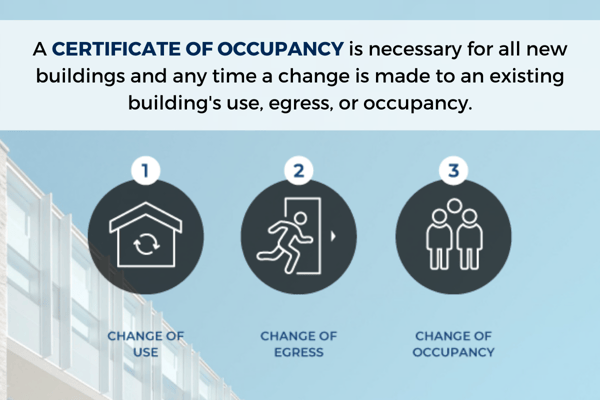For a commercial office building, obtaining a Certificate of Occupancy (C of O) or Temporary Certificate of Occupancy (TCO) is the most critical step in the building closeout process, and also the most challenging. Yet, without the issuance of a C of O or TCO, the building can't be legally occupied by tenants.
The NYC DOB issues the Temporary Certificate of Occupancy (TCO) in situations where construction work is completed to an extent that allows for occupancy. This comes as a benefit to NYC's many high-rise multi-tenant buildings because it allows for completed portions of the building to begin operating while other parts of the building may still be under construction.
As much as they are a benefit, TCOs can also become problematic after 18 months or longer have passed since initial inspection. The steps involved in converting a TCO to a final C of O, because of the many complexities involved in densely populated multi-story buildings, can result in many years of TCO renewals.
This is where the new Interim Certificate of Occupancy enters the picture. City Council has proposed a bill that would create a new class of C of Os that would authorize the DOB to issue a certificate which acts the same as a final C of O in terms of finality, but different in that it can be issued to a single floor or group of floors within a building. Being that the bill is expected to be signed into law before the end of the year, we took a close look at the specifics of the legislation and outlined the key points the real estate community needs to know about.
Certificate of Occupancy (C of O)
First, let's back up and establish what a C of O is and why it's important to the closeout process.
Essentially, a C of O is a document that states the legally intended use of a building, permitted occupancy, compliance with code, and that all violations have been paid or resolved.
A C of O is needed for all new buildings, but also when any changes are made to an existing building's:
- Use
- Egress
- Occupancy

The DOB issues a Final C of O when the completed work matches the submitted plans for new buildings or major alterations. This confirms that the work complies with all applicable codes, all paperwork has been processed, all necessary city agency approvals obtained, all fees paid, and all relevant violations resolved.
Temporary Certificate of Occupancy (TCO)
The DOB issues a Temporary Certificate of Occupancy (TCO) in the short term when a structure is safe to occupy but requires additional work or permits to be eligible for receiving a final C of O. While a TCO indicates that the property is safe for occupancy, it has an expiration date. TCOs expire 90 days after they are issued and must be continually renewed.
Interim Certificate of Occupancy
Sponsored by Council Member Robert Cornegy, the City Council has introduced a new class of certificate that would replace the TCO.
Separate from TCOs, the new Interim Certificate of Occupancy would enable portions of the building where construction is complete to open, but with less red-tape hassle for building owners and developers.
The key difference between the two is that Interim C of Os would not need to be renewed every 90 days. This is a big advantage for buildings where entire floors are completed and signed off on, but not all construction in the building is done. An Interim C of O would eliminate the need to go through the renewal process every three months and risk receiving fines for failure to renew.
Under the new proposed code, if a company wanted to occupy three floors of a building, as long as they completed all of the required sign offs (plumbing, sprinkler, standpipe, fire alarm, special inspections, etc.), they would be able to receive their Interim Certificate of Occupancy and close out the project. If however, DOB’s concludes there are fire and life safety work not signed off in other parts of the building that could affect the safety of the whole building, a TCO would remain in place.
Additionally, certain properties would not be eligible for receiving the Interim C of O, including residential buildings under eight stories or with less than four apartments, non-residential buildings under five stories, mixed-use buildings with fewer than four apartments, and parking structures.
In the end, however, the introduction of the Interim C of O could represent a substantial streamlining of C of O processes that would allow businesses and others to open with reduced paperwork and wait times. Such advantages are crucial in the COVID-19 era when flexibility and responsiveness are key.
DOB Commissioner Melanie La Rocca commented, "This new type of certificate of occupancy would reduce paperwork, free up staffing resources at the department, and streamline the development process, all without diminishing safety."
With the Interim C of O bill expected to pass into law before the end of 2020, the DOB is currently working to build the new Interim C of O process into the DOB NOW: Build module. Until then, TCOs will be eligible for renewal until a Final C of O can be obtained or the Interim C of O protocols are finalized. Once the module is complete and the bill is passed, training on the new Interim C of O process will be made available to the public.
Turn to Milrose to reach closeout through the new Interim C of O
 Here at Milrose, we are looking forward to partnering with our clients and leading the construction world forward with the implementation of the new methodology outlined in this bill.
Here at Milrose, we are looking forward to partnering with our clients and leading the construction world forward with the implementation of the new methodology outlined in this bill.
If your building is under rolling TCO renewals, contact us today so we can rid you of the municipal burden you are facing and bring your project to closeout through utilizing the new Interim C of O process.
Also, make sure to subscribe to Milrose Insights and stay tuned for a special upcoming piece we will be sharing on 'Demystifying the Interim C of O Process.'







